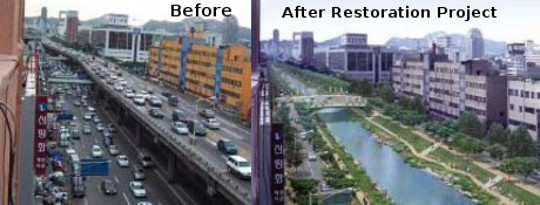Once upon a time, there was a river that ran through the downtown of a busy city. In the 1970s the river was covered by a busy, multi-lane and elevated highway.
However many years later, in the year 2000, an engineering survey found that the road had several structural weaknesses and that it would be very costly to renovate the road. So instead, the city government decided to demolish the road and restore the flow to the river in order to make the downtown area more beautiful and environmentally healthy.
A two year project was begun in 2003 costing nearly one billion dollars. The traffic was rerouted, the river re-exposed, bridges were built, a bus rapid transit system was started, and many public parks and recreational spaces were created.
People then had cleaner air to breathe and the summer temperatures were cooler due to the presence of the river and the absence of the cars and highway.
A Fairy Tale Come True?
While this story sounds like a fairy tale, it is exactly what took place in the downtown area of the South Korean city of Seoul.
"Prior to restoration, more than 168,000 cars traversed this stretch each day, and 62.5% of these were through-traffic. The consequences of this congested transit system along Cheonggye Street had grown very serious. Air pollution--particularly criteria pollutants--was well above acceptable levels, and nitrogen oxide pollution exceeded the environmental air quality standard for Seoul. Moreover, levels of benzene, a carcinogenic Volatile Organic Compound (VOC), were also high. A health awareness survey of people living or working near Cheonggyecheon suggested that the residents were more than twice as likely to suffer from respiratory diseases compared to people in other areas (SDI, 2003A). In addition to air pollution, noise pollution along this stretch topped established standards for commercial areas and was a serious hindrance to a pleasant living and working environment.
"These improvements in environmental conditions have been accompanied by the return of several species of birds, fish and insects to the restored Cheonggyecheon. The enthusiasm and excitement engendered by this project have attracted the attention of cities elsewhere and have made it a model for other urban renewal efforts." (Global Restoration Network)
While many citizens of Seoul -- especially the business people located near the highway -- were initially opposed to the project, the consequences of the restoration were beneficial to all. The area now attracts tourists, and the locals also make great use of the parks along the river's banks. The personal, as well as economic benefits, have been numerous.
"The City of Seoul is in the process of an important paradigm shift, changing from an autocentric development-oriented urban landscape to one that values the quality of life of its people and the importance of functioning ecosystems. By demolishing an elevated freeway and uncovering a section of the historic Cheonggyecheon Stream, the Cheonggyecheon Restoration Project created both ecological and recreational opportunities along a 3.6-mile corridor in the center of Seoul. The project has proven catalytic, spurring economic growth and development in an area of Seoul that had languished over the last several decades." (Landscape Architecture Foundation)
An Example for All?
 These type of renovations are taking place all over the world. Citizens and city planners are realizing the impact of major pollution corridors (highways) that traverse major cities. In many cases, as in the case of Seoul, the majority of the traffic is simply "passing through" and is of no actual benefit to the city or its residents. The locals not only have to contend with the extra traffic in their midst, contributing to traffic problems, but they also have to live with the consequential health and environmental issues due to air and noise pollution.
These type of renovations are taking place all over the world. Citizens and city planners are realizing the impact of major pollution corridors (highways) that traverse major cities. In many cases, as in the case of Seoul, the majority of the traffic is simply "passing through" and is of no actual benefit to the city or its residents. The locals not only have to contend with the extra traffic in their midst, contributing to traffic problems, but they also have to live with the consequential health and environmental issues due to air and noise pollution.
Perhaps it is time to revisit our priorities when it comes to our living environment. At a time when a lot of the infrastructure in the USA needs revamping, we might consider that doing it the "same old way" is not the best way. A new fresh look at possible solutions, as in the case of Seoul, is probably needed.
Read more at:
Preservation Institute (includes history of the river)
Landscape Architecture Foundation (includes sustainable features, challenges, solutions, cost comparisions, lessons learned)
Commission for Architecture and the Built Environment (CABE)



























